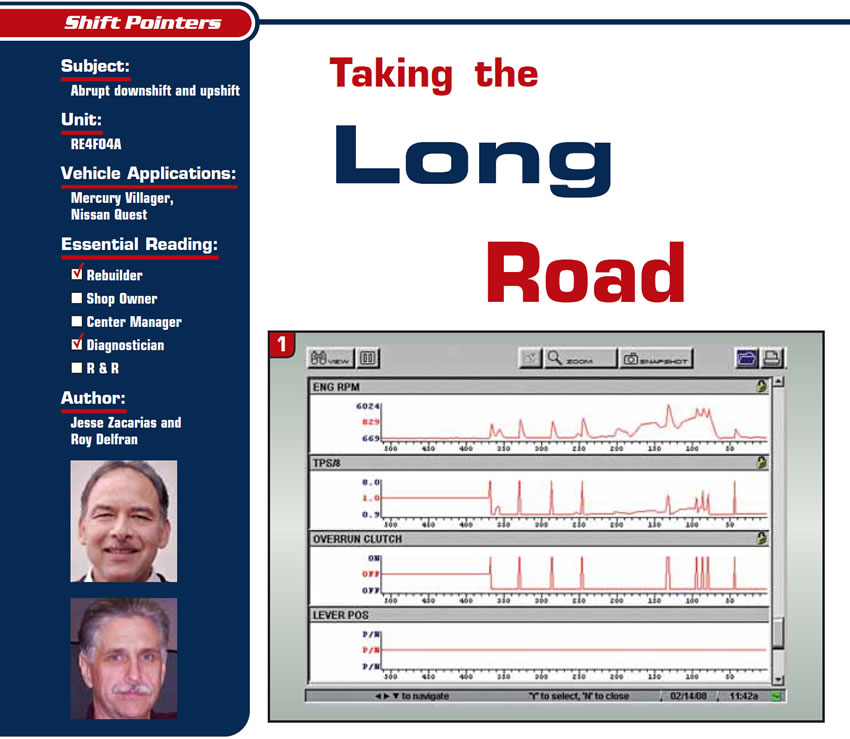
Shift Pointers
- Subject: Abrupt downshift and upshift
- Unit: RE4FO4A
- Vehicle Application: Mercury Villager, Nissan Quest
- Essential Reading: Rebuilder, Diagnostician
- Authors: Jesse Zacarias and Roy Delfran
A 1994 Mercury Villager with a Nissan RE4FO4A transmission came in with an abrupt downshift and upshift coinciding with the accelerator being depressed and released and was more noticeable at freeway speeds (about 60 mph).
We checked for codes and found that none was present. However, we did notice under “data” in the scan tool that the lever-position parameter showed neutral in the Drive and manual-second positions. All the other lever positions read fine. We also noticed that when we accelerated with the lever in Park, the overrun-clutch parameter went from off to on after the accelerator passed the halfway point (2.2V) (see Figure 1).
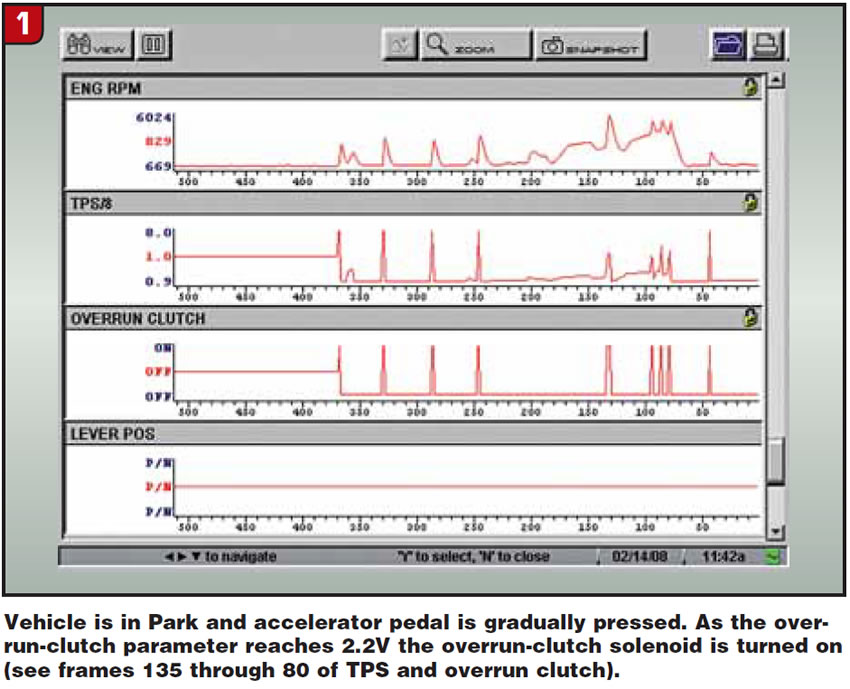
Since we had not seen this before, we went directly to the TCM to get all the input readings including the inhibitor-switch input, and as expected we did not get voltage at pin 27 (manual 2nd) and 34 (drive) (see Figure 2), which are inputs from the inhibitor switch, but all the other TCM inputs seemed normal. The inhibitor switch sends battery voltage to the TCM depending on the gear selected through pins 26, 27, 34, 36 and 35. If voltage fails to get to the TCM when the lever position is changed, then the TCM shows the last signal received (in this case neutral).
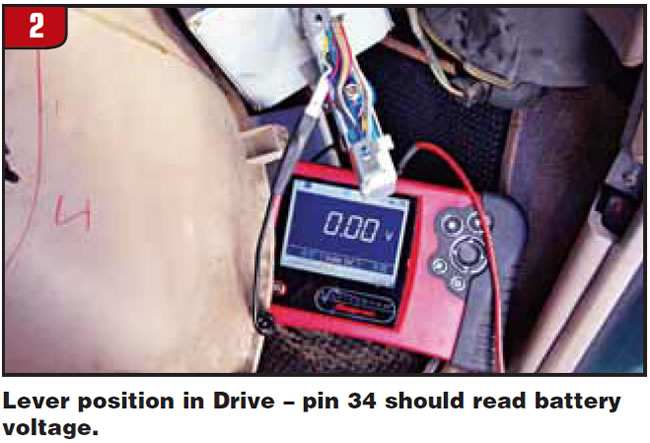
The inhibitor switch was failing in both the Drive and second-gear-select positions (open voltage). This meant that as we were driving, the TCM thought the vehicle was in Park or neutral, as that was the last signal received. As a result, the TCM turned off the overrun-clutch solenoid, thus engaging the overrun clutch, which in itself is no problem; however, when the vehicle reached about 60 mph (about half throttle in the TPS), the TCM would turn the overrun-clutch solenoid on, thus disengaging the overrun clutch. This meant that when we accelerated, the overrun-clutch solenoid was turned on, and when we decelerated, the overrun-clutch solenoid was turned off (see Figure 3). This was causing the feeling of an abrupt deceleration and acceleration.
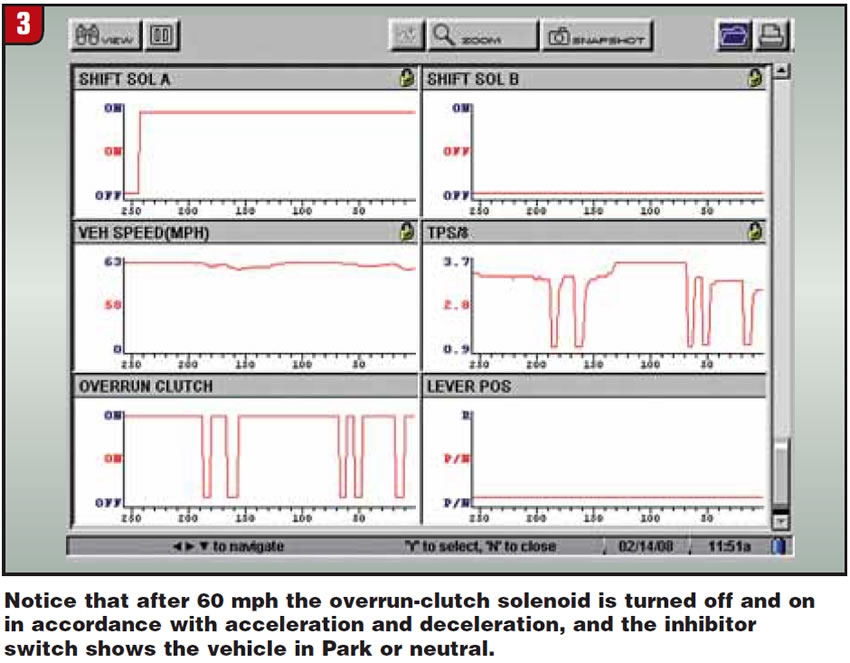
After we replaced the inhibitor switch, normal operation of the overrun-clutch solenoid returned in Drive during acceleration and deceleration, making the TPS signal voltage go from low to high as shown in Figure 4.
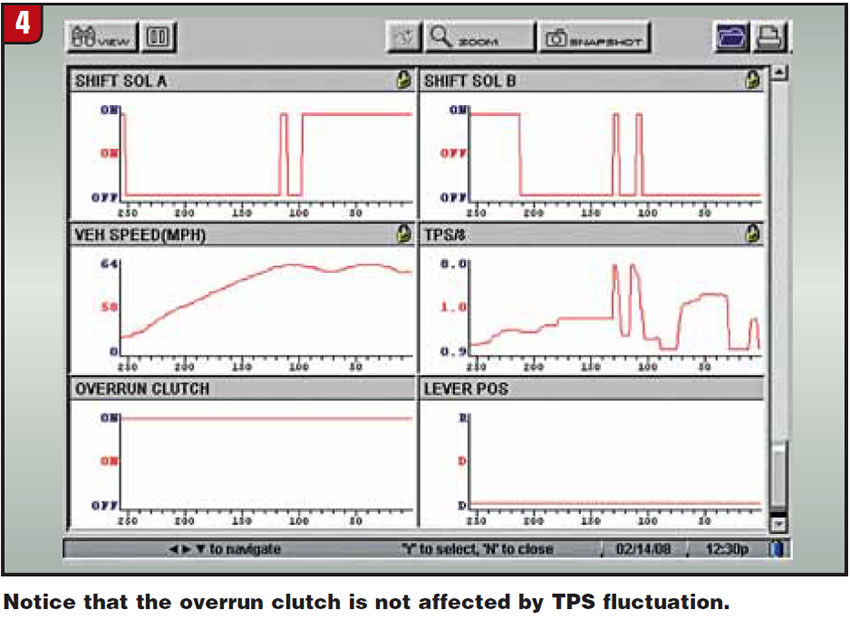
It appears that Nissan has designed the overrun-clutch solenoid to operate opposite of what we are accustomed to seeing. That is, when the overrun-clutch solenoid is energized on, the overrun clutch is disengaged, and when it is turned off the overrun clutch is engaged.
Contributing to this problem is the “data” parameter that reads “overrun clutch.” it is our opinion that it would be better if it read “overrun solenoid.”
Nissan also has programmed the TCM to control the overrun clutch in Park and neutral. When the vehicle is put in those stages the overrun-clutch solenoid is turned off, engaging the overrun clutch, and if the accelerator pedal is pressed past half throttle the solenoid will turn on, disengaging the overrun clutch. Also when the transmission is in Drive and the TPS passes the halfway mark the overrun-clutch solenoid is turned on, regardless of the position of the overdrive-cancel switch. Why this is programmed in the TCM is not clear to us, but it appears that the programming of the TCM was contributing to the cause of this problem, since it was not allowed to see that the vehicle was going 60 mph in neutral.
What also was puzzling was that solenoids A and B were in the fourth-gear stage while the overrun-clutch solenoid was turned off, thus allowing the overrun clutch to come on (see Figure 3). Why no bind-up?
Here is what we found out. Two major things must occur for a fourth-gear shift. First, solenoid A must go from off to on, thus stroking shift-solenoid valve A and sending overdrive-band apply oil to the overrun-clutch control valve. Second, the overrun-clutch solenoid must be on to stroke the overrun-cutch control valve, thus opening the passage for the overdrive-band apply oil to reach the overdrive band.
The overrun-clutch control valve serves as a safety feature, since it can be in only one of two stages. One is stroked in (overrun solenoid on), which opens the overdrive-band apply passage and at the same time closes the overrun-clutch passage. Second stage is resting (overrun-clutch solenoid off); the spring closes the valve, thus closing the passage of the overdrive-band apply oil and at the same time opening to exhaust any oil in the overdrive band. At this stage the overrun-clutch apply passage is also opened. So as we can see, depending on the stage of the overrun-clutch control valve, only one thing can be applied – either the overdrive band or the overrun clutch.
So here’s what was going on: When we accelerated the vehicle, the TCM was shifting the transmission into overdrive and turning on the overrun-clutch solenoid, thus achieving fourth gear. When we decelerated, the TCM was turning off the overrun-clutch solenoid, thus applying the overrun clutch while the overrun-clutch control valve was downshifting the transmission to third; this caused the abrupt feeling.
This information is not easily available; you have to read very careful the factory solenoid-application chart. As far as we can determine this applies even to the late-model RE4FO4A found in the Mercury vehicles and Nissan Quest.
We could have just replaced the inhibitor switch when we saw that it failed, but then we wouldn’t have been able to account for the pesky overrun-clutch solenoid turning on and off in Park in accordance with the accelerator pedal’s position. Sometimes you have to take the long road to find the answers.

Jesse Zacarias is the owner of Elec-Tran Diagnostics in Gilroy, Calif. Roy Delfran is with Snap-on Diagnostics’ Ask A Tech Community Web Forums (http://askatech.snapon.com).













